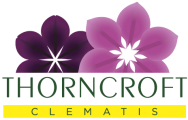Windy Aspects
If you are looking for clematis to grow in a position that is exposed to a lot of wind, those in the following groups will cope best. As well as these groups you can use most clematis where the Average Flower Size is less than 3 inches.
Atragene Group - Spring flowering cultivars with nodding bell-like flowers. They are all very hardy, but require a free draining situation. They do not need the 'rich' growing conditions or deep planting that the large flowered cultivars prefer.
Diversifolia Group - These herbaceous cultivars are clump-forming scramblers, or semi-climbers, derived directly, or indirectly from the integrifolia species. In general, they have non-clinging stems and they can be allowed to scramble in herbaceous borders. Alternatively, they can be used to clamber through open shrubs, small trees, rambler and shrub roses or obelisks. They are all hardy, very free flowering, trouble-free clematis and are highly recommended. All the clematis in this group are suitable to use as cut flowers.
Integrifolia Group - These herbaceous cultivars are clump-forming scramblers, they have non-clinging stems and can be allowed to scramble in herbaceous borders. They are good 'front of border' plants and also make excellent companions in beds of bush roses. They are exceptionally hardy, very free flowering and as with other herbaceous plants, they die back in winter. They are all suitable to use as cut flowers.
Viticella Group - They are all extremely hardy, very free flowering, their pruning is simple and they cannot be recommended highly enough. Especially useful for people new to growing clematis as they are extremely tolerant of what the gardener does to them!
Tangutica Group - The clematis in this group are extremely useful in the garden, providing colour and interest from mid-summer through to late autumn, with most producing excellent seedheads for added interest in the winter months. They cope happily with poorer growing conditions and are drought tolerant.
